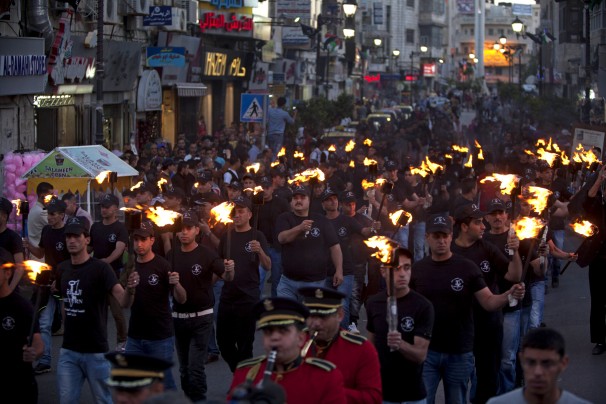JERUSALEM — This is the month of clashing narratives in Israel and the Palestinian territories. Last week, Israel held a remembrance day for its war dead and celebrated 66 years of statehood. On Thursday, the Palestinians commemorate the Nakba, or the catastrophe, marking the flight and expulsion of an estimated 700,000 Palestinians from Israel more than six decades ago.
Most Israeli Jews tend to ignore Nakba Day, which is marked in the Palestinian territories of the West Bank and the Gaza Strip, just as Palestinians in Nablus or Hebron pay little mind to fireworks celebrating the 1948 birth of Israel.
But nowadays, Nakba commemorations by Palestinian citizens of Israel are becoming more public and more assertive. And they come with a modern twist, such as a mobile app that pinpoints in Hebrew, Arabic and English the location of more than 500 Palestinian villages that were emptied, overrun or abandoned in the 1948 war.
The free iNakba app for iPhones was made available last week by Zochrot, a pro-Palestinian Israeli group based in Tel Aviv. Since then, there have been 12,000 downloads. (An Android version is coming soon, the group says).
The app shows a Google map of Israel covered with hundreds of brown pins, each representing one of the depopulated Palestinian villages that exist today as, for example, an empty hilltop, a rubble pile, an olive grove, a prison, a ruin or an Israeli town.
Tap a pin, and the name of the old village appears. Tap the name, and a photograph of the site follows, with a screen of information: estimated Palestinian population in 1948, the Israeli military unit that occupied the village, its fate and so forth.
“This is not a new idea. There are many maps — maybe too many maps — of the villages destroyed. But people do not use paper anymore. They use smartphones and GPS and apps, and so this is the tool we are using to reach them,” said Raneen Jeries, a coordinator for the project at Zochrot.
Users of iNakba can log on and add photographs and video. There are plans to provide detailed text to the app.
“We expect an angry response,” Jeries said, because the iNakba app is designed to both inform and provoke.
On Israel’s Independence Day last week, thousands of Arab Israelis marched under a banner reading, “Your independence is our Nakba.”
The protesters also waved flags belonging to the Palestinian political faction Fatah and of Hamas, the militant Islamist group that controls Gaza and is branded a terrorist organization by Israel and the United States. Hamas has a history of firing rockets at Israel.
Israeli Foreign Minister Avigdor Lieberman condemned the demonstrators as “fifth columnists” and said, “To those Arabs who took part today in the ‘Nakba Day’ procession and waved Palestinian flags, I suggest that next time they march directly to Ramallah and they stay there.” Ramallah is the center of government for the Palestinian Authority in the West Bank.
The next day, Jamal Zahalka, an Arab-Israeli lawmaker in Israel’s parliament, was quoted by a Palestinian newspaper as saying that Independence Day should be called “occupation day.”
More than 20 percent of Israel’s population is Arab or Palestinian, most of them Muslims and a few Christian.
Benny Morris, an Israeli historian and author of “1948: The First Arab-Israeli War,” said that 20 years ago, Israelis were more interested in, and even sympathetic to, learning about the events that led to the mass exodus of Palestinians in 1948.
Today? Not so much. Morris said that after the suicide bombings of the second intifada, or uprising, in the early 2000s and the failure of the late Palestinian leader Yasser Arafat to make a peace deal, Israelis changed the channel.
“I would say Israelis today are less open to hearing the Palestinian story,” Morris said, adding that he doubts that Palestinians, especially youths, are interested in the Israeli narrative, either.
What is new, he said, is the growing assertiveness among Arab Israelis in commemorating the Nakba. This, he said, “worries Israelis.”
Groups such as Zochrot call for the return of Palestinian refugees who were pushed out or who fled in 1948. If such a return were to happen — and Israel’s current leaders have been adamant that it will not — a few million Palestinian refugees and their descendants could overwhelm the Jewish makeup of the state.
A recent debate between an Arab Israeli lawmaker and a Jewish Israeli legislator highlights the conflict: The two could not agree on basic historical events, let alone their interpretation.
Such a debate is especially interesting now, as Israeli Prime Minister Benjamin Netanyahu seeks legislation to formally declare Israel a “Jewish state.”
Haneen Zoabi, the Arab Israeli legislator, told her counterpart, “You can dream, but not at my expense. Your dream clashed with my reality, and you don’t see it.”
Omer Bar-Lev, a lawmaker from the Labor Party, countered that when the early Zionists arrived in Israel, “Palestine was not inhabited by millions of Palestinians. Most of Palestine was swamps, and my father and mother and the newcomers came to Israel, and some of them died drying those swamps.”
Bar-Lev said, “It is not that the Jews came and threw them out.”



